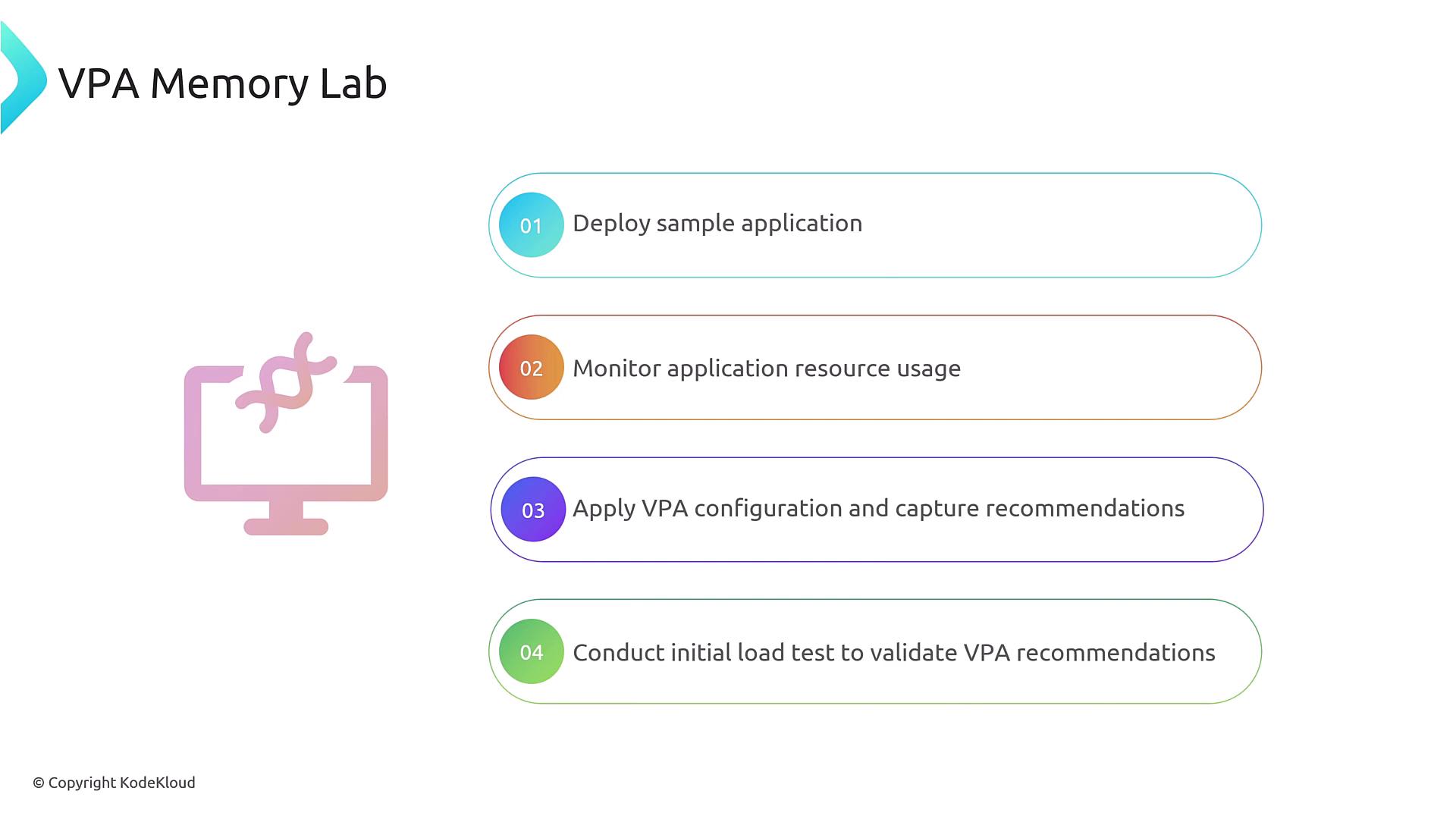Kubernetes Autoscaling
Vertical Pod Autoscaler VPA
VPA Memory Lab
Welcome to the VPA Memory Lab! In this tutorial, you’ll deploy a sample Flask application on Kubernetes, monitor its memory usage, configure a Vertical Pod Autoscaler (VPA), generate load, and review VPA memory recommendations. By the end, you’ll understand how VPA adjusts resource requests to match real-world demand.

Step 1: Deploy the Sample Flask Application
Apply the deployment and service manifest:
kubectl apply -f vpa-testing.yml
Expected output:
deployment.apps/flask-app created
service/flask-app-service created
Confirm the pods are running:
kubectl get pods
NAME READY STATUS RESTARTS AGE
flask-app-b85fc57d4-kmsdl 1/1 Running 0 2m
flask-app-b85fc57d4-zn77q 1/1 Running 0 2m
Step 2: Check Current Resource Usage
Before load testing, inspect CPU and memory usage:
kubectl top pod
NAME CPU(cores) MEMORY(bytes)
flask-app-b85fc57d4-g2n7n 1m 19Mi
flask-app-b85fc57d4-mq6kb 1m 19Mi
| Metric | Description | Command |
|---|---|---|
| CPU Usage | Current CPU consumption per pod | kubectl top pod |
| Memory Usage | Current memory consumption per pod | kubectl top pod |
Step 3: Apply the VPA Configuration
Create a VPA manifest (vpa-memory.yaml) to manage memory requests for your Flask deployment:
apiVersion: autoscaling.k8s.io/v1
kind: VerticalPodAutoscaler
metadata:
name: flask-app
spec:
targetRef:
apiVersion: apps/v1
kind: Deployment
name: flask-app
updatePolicy:
updateMode: "Off"
resourcePolicy:
containerPolicies:
- containerName: '*'
controlledResources: ["memory"]
minAllowed:
memory: 150Mi
maxAllowed:
memory: 1000Mi
Warning
The updateMode: Off setting prevents VPA from automatically updating pods. You’ll receive recommendations only.
Apply the VPA manifest:
kubectl apply -f vpa-memory.yaml
verticalpodautoscaler.autoscaling.k8s.io/flask-app created
Initial VPA Recommendation
Check the initial memory recommendation:
kubectl get vpa flask-app -o yaml
status:
conditions:
- type: RecommendationProvided
status: "True"
lastTransitionTime: "2025-01-15T08:10:03Z"
recommendation:
containerRecommendations:
- containerName: flask-app
lowerBound:
memory: 262144k
target:
memory: 262144k
uncappedTarget:
memory: 262144k
upperBound:
memory: 1000Mi
| Field | Meaning |
|---|---|
| lowerBound | Minimum request to ensure stability |
| target | Ideal request within policy bounds |
| uncappedTarget | Recommendation without considering min/max limits |
| upperBound | Maximum request allowed by the VPA policy |
Step 4: Run a Load Test and Validate Recommendations
Generate load against your Flask application:
sh load.sh
Once the load test completes, retrieve the updated VPA recommendation:
kubectl get vpa flask-app -o yaml
status:
recommendation:
containerRecommendations:
- containerName: flask-app
lowerBound:
memory: 262144k
target:
memory: "511772K"
uncappedTarget:
memory: "511772K"
upperBound:
memory: 1000Mi
Notice that target has increased to meet higher memory demands under load. If the uncappedTarget exceeds your upperBound, you can:
- Adjust
maxAllowedin the VPA policy - Consider a Horizontal Pod Autoscaler for scaling out
Next Steps
After validating recommendations, you can switch updateMode to Auto or Recreate to let VPA apply changes automatically.
Links and References
Watch Video
Watch video content
Practice Lab
Practice lab